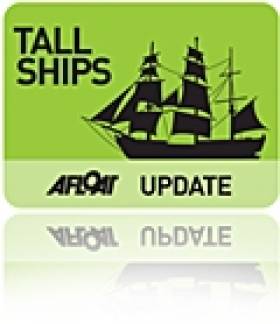Displaying items by tag: Juan Sebastián de Elcano
Spanish Royal Navy Tall Ship Arrives in Dublin Port
#tallship – This morning saw the world's third-largest Tall Ship, the Juan Sebastián de Elcano, greeted by Dublin Port Company tug boats and a flotilla of yachts from local sailing clubs in a ceremonial escort to mark the ship's arrival in Dublin Port.
As Afloat.ie reported earlier, the magnificent 370ft, four-masted steel-hulled Royal Spanish Navy schooner will be open to the public to visit for free during her five-day stay in the capital to promote Spanish-Irish cultural exchange. Click HERE for public opening dates, times and locations.
Tallship – The world's third largest tall ship is currently anchored in Dublin Bay and waiting to come into Dublin Port where it will open to the public. The Spanish 370–foot long, four-masted Juan Sebastián de Elcano – is set to sail into Dublin tomorrow (7 June) for a five-day visit.
This majestic ship will be open to the public at the following times:
At Sir John Rogerson's Quay from 12pm to 1pm and 3.30pm to 7pm on Sunday 8th June, and from 10am to 12pm and 3.30pm to 7pm on Monday 9th June
Then later at Alexandra Basin from 3.30pm to 7pm on Tuesday 10th June, and from 10am to 1pm and from 3.30pm to 7pm on Wednesday 11th June. Access to the ship in Alexandra Basin is via a free shuttle bus service from Dublin Port Company's headquarters on Alexandra Road, Dublin 1.
As Afloat.ie reported earlier, The steel-hulled schooner will be escorted into Dublin Port at 7.30 am Saturday Morning by two Dublin Port Tug Boats and local yachts in Flotilla. Cruisers and yachts are welcome to take part.
Led by Captain Enrique Torres Piñeyro, the Elcano is used primarily as a training ship for the Royal Spanish Navy, preparing its officers for long periods at sea.It will arrive in Dublin with 191 crew, who will participate in a five-day programme of engagements to promote Spanish-Irish cultural exchange.
The ship, currently is on its 85th training voyage and has been sailing for 23 days across the Atlantic from the Port of New York to Dublin Port. Built in Cádiz (Spain) in 1928, the Elcano has visited 152 ports in more than 70 countries, and of its 85 cruises to date, 10 have been round-the-world trips. The Elcano last visited Dublin in July 1999. After leaving Dublin next Thursday, it will visit Hamburg, Germany and Fredrikstad, Norway before returning to Spain.
World's Third Largest Tall Ship is Dublin Bay Bound
#tall ship – Straight after a weekend of Tall Ships on Dublin Bay, the Spanish Embassy in Dublin and Dublin Port Company have announced that the world's third-largest Tall Ship, the 370 foot long, four-masted "Juan Sebastián de Elcano" will visit Dublin from Saturday, 7th until Thursday, 12th June.
The impressive steel-hulled schooner will be met by two Dublin Port Company tug boats and a flotilla of yachts from local sailing clubs in a ceremonial escort to mark the ship's arrival at 7.30am this Saturday in Dublin Bay.
Led by Captain Enrique Torres Piñeyro, the "Elcano" is used primarily as a training ship for the Royal Spanish Navy, preparing its Officers for long periods at sea. She will arrive in Dublin carrying 191 crew on board, who will participate in a five-day programme of engagements in the capital to promote Spanish-Irish cultural exchange.
This includes a number of free public open days, when Dubliners and visitors to the city will be able to board and inspect this magnificent vessel up close in the following locations:
At Sir John Rogerson's Quay:
Sunday 8th June: 12.00 to 13.00 and 15.30 to 19.00;
Monday 9th June: 10.00 to 12.00 and 15.30 to 19.00
At Alexandra Basin*:
Tuesday 10th June: 15.30 to 19.00;
Wednesday 11th June: 10.00 to 13.00 and 15.30 to 19.00
The ship, now on its 85th training voyage, has been sailing for 23 days across the Atlantic from the Port of New York en route to Dublin Port. Built in Cádiz (Spain) in 1928, the "Elcano" has visited 152 ports in more than 70 countries, and of its 85 cruises to date, 10 have been round-the-world trips. The last time the "Elcano" visited Dublin was in July 1999. Her next ports of call include Hamburg, Germany and Fredrikstad, Norway before returning to Spain.
Eamonn O'Reilly, Chief Executive of Dublin Port Company, said: "Dublin Port Company is delighted to welcome the Juan Sebastián de Elcano and her crew to Dublin Port. As a PORT CITY, it's an honour for Dublin Port to host the world's third-largest Tall Ship in full view of the city, where she is certain to receive a very warm welcome. I would strongly encourage Dubliners and visitors to the city to take this unique opportunity to visit this spectacular naval ship, and share in Spain's maritime history and culture over the coming days."
Javier Garrigues, Spanish Ambassador to Ireland, said: "The arrival to Dublin of the Elcano is an event of major importance and significance. It symbolises the strength of the bilateral relations between Ireland and Spain, two nations united throughout history by close ties, nowadays reinforced by their common membership of the EU. The fact that Dublin has been chosen as a port of call by the Elcano is proof of the importance Spain attaches to Ireland. I am convinced that Elcano´s visit will further enhance the mutual understanding and friendship between the two countries."































































